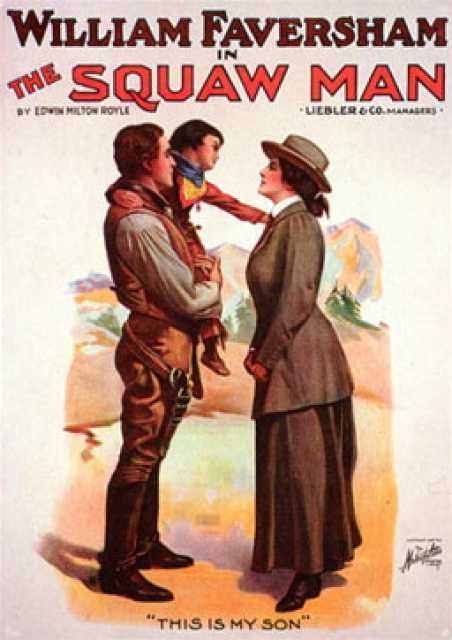Synopsis in German
James Wynnegate is made executor of funds raised by members of his regiment for the families of men killed in battle. His cousin, the Earl of Kerhill, embezzles the funds, but Kerhill's wife Diana, with whom Wynnegate is in love, convinces the latter to take the blame and leave England in order to save the family's honor. Wynnegate eventually goes to Wyoming and buys a ranch using the name Jim Carston. He is saved from an attack by Cash Hawkins by the Indian maiden Nat-U-Ritch and he marries her when he learns that she is pregnant. Some time later, Diana comes West with news that Kerhill is dead, but that he had admitted his theft shortly before death. Nat-U-Ritch, knowing that her husband will send their young son Hal away, and hearing that she will be arrested for killing Hawkins, commits suicide. At the end, Diana embraces Hal. (Turner Classic Movies)
As their first property, they chose a story that appeared to be an easily exploitable property: The Squaw Man, written by Edwin Milton Royle. It had begun as a successful stage play in 1905 (featuring future cowboy star William S. Hart), and had been revived in 1907, 1908 and 1911. At a price of $5,000, the filmmakers recruited the star of the 1911 run, Dustin Farnum. Because DeMille had no experience as a filmmaker (his apprenticeship consisted of a single day at the Edison Studios), Oscar Apfel was brought along to co-direct, and to help initiate the producers into the world of filmmaking.
In 1913 (when The Squaw Man began filming), plenty of motion pictures were being filmed outdoors, but generally within driving distance to the studios in New York and New Jersey. DeMille recognized the power of exotic scenery and intended to use sweeping plains and imposing mountains as the key visual component of his film, so he boarded a train west, bound for the picturesque-sounding Flagstaff, Arizona. Unfortunately, Flagstaff failed to deliver such awesome vistas. Discouraged but not broken, De Mille, Farnum & Co. remained on the train until it reached the end of the line: the junction city of Los Angeles. They drifted into the sleepy community of Hollywood and rented a large barn at Vine and Selma Streets for $200 per month. The barn was the seed from which Paramount Pictures would eventually grow, and still stands today, preserved as a museum of early Hollywood filmmaking. On December 29, 1913, the cameras began to turn.
The melodrama concerns itself with the honor of Captain James Wynnegate (Farnum), a peer of England. When his cousin, Sir Henry (Monroe Salisbury) embezzles money from an orphans' fund to pay his gambling debts, James accepts the blame and is banished from high society. When the ship upon which he is traveling burns and sinks, James is rescued and taken to America. Disgusted by the crime and chicanery of the big city, he accepts a Westerner's invitation to travel with him back to the plains. The sophisticated Britisher is at first mocked, but quickly earns the respect of the rangehands, with the exception of the villainous rustler, Cash Hawkins (William Elmer). When Nat-U-Rich (Red Wing), a native American woman, saves his life, they fall in love and are married. Suffering financial hardship, James's future seems grim, until a dying confession, an unexpected reunion with an old flame (Winifred Kingston) and a fateful shoot-out bring the film (already bursting at the seams with narrative) to a surprising and elaborately plotted resolution.
Cecil B. DeMille would later become synonymous with grandiose spectacle, and even in The Squaw Man, one detects his strong visual sense. To add scale and drama to scenes in a small western town, he constructed a set for the depot/general store within a few feet of a roalroad track, so that scenes filmed there are punctuated by a roaring steam enging passing almost through the set.
Even in his first film, DeMille displayed a keen eye for lighting (influenced by the stage plays of David Belasco). Using rudimentary techniques, DeMille and cinematographer Alfred Gandolfi managed to the effects of firelight and candlelight so that the visual impact of their western was not limited to the quantity of actors on screen, but the quality of the compositions in which they are presented.
Upon the completion of The Squaw Man, the producers (and any exhibitors who screened the film) were shocked to find the film periodically shifting up and down on the screen. The inexperienced DeMille and Lasky prepared to file a lawsuit against the Eastman Kodak Company. They consulted film pioneer Sigmund Lubin, who explained that the defect was not the film. "You used two different cameras, didn't you?" asked Lubin, according to Terry Ramsaye's book A Million and One Nights. "That's why...two different frame lines -- that makes the picture jump." DeMille made sure the cameras were properly calibrated after that, and Lubin secured a lucrative contracted to "fix" the negative and process all the distribution prints of the film. (Bret Wood, Turner Classic Movies)
Remarks and general Information in German: "One-act versions of the play were produced as early as 1904. Modern sources credit the screenplay to DeMille and Apfel, the photography to Alfred Gandolfi, the editing to Mamie Wagner, and the art direction to Wilfred Buckland. This was the first release of the Jesse L. Lasky Feature Play Co. Although this was not the first motion picture to be filmed in Hollywood, The Squaw Man was the first Hollywood-made feature-length production. In addition to the 1918 version of the film, DeMille directed another version for M-G-M in 1931, starring Warner Baxter, and a 1917 sequel, entitled The Squaw Man's Son ." (Turner Classic Movies)
 Plakatmotiv The Squaw Man, © Lasky Feature Play Company
Plakatmotiv The Squaw Man, © Lasky Feature Play Company